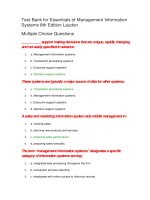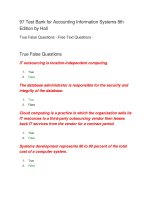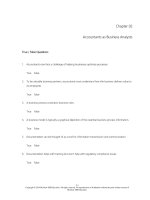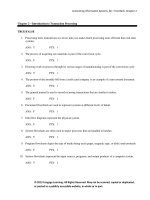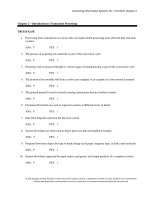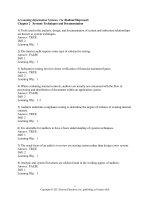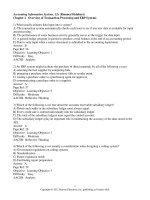Accounting information systems 8th edition hall test bank
Bạn đang xem bản rút gọn của tài liệu. Xem và tải ngay bản đầy đủ của tài liệu tại đây (609.5 KB, 26 trang )
Accounting Information Systems, 8e—Test Bank, Chapter 2
Chapter 2—Introduction to Transaction Processing
TRUE/FALSE
1. Processing more transactions at a lower unit cost makes batch processing more efficient than real-time
systems.
ANS: T
PTS: 1
2. The process of acquiring raw materials is part of the conversion cycle.
ANS: F
PTS: 1
3. Directing work-in-process through its various stages of manufacturing is part of the conversion cycle.
ANS: T
PTS: 1
4. The portion of the monthly bill from a credit card company is an example of a turn-around document.
ANS: T
PTS: 1
5. The general journal is used to record recurring transactions that are similar in nature.
ANS: F
PTS: 1
6. Document flowcharts are used to represent systems at different levels of detail.
ANS: F
PTS: 1
7. Data flow diagrams represent the physical system.
ANS: F
PTS: 1
8. System flowcharts are often used to depict processes that are handled in batches.
ANS: T
PTS: 1
9. Program flowcharts depict the type of media being used (paper, magnetic tape, or disks) and terminals.
ANS: F
PTS: 1
10. System flowcharts represent the input sources, programs, and output products of a computer system.
ANS: T
PTS: 1
© 2013 Cengage Learning. All Rights Reserved. May not be scanned, copied or duplicated,
or posted to a publicly accessible website, in whole or in part.
Accounting Information Systems, 8e—Test Bank, Chapter 2
11. Program flowcharts are used to describe the logic represented in system flowcharts.
ANS: T
PTS: 1
12. Batch processing systems can store data on direct access storage devices.
ANS: T
PTS: 1
13. Backups are automatically produced in a direct access file environment.
ANS: F
PTS: 1
14. The box symbol represents a temporary file.
ANS: F
PTS: 1
15. Auditors may prepare program flowcharts to verify the correctness of program logic.
ANS: T
PTS: 1
16. A control account is a general ledger account which is supported by a subsidiary ledger.
ANS: T
PTS: 1
17. The most significant characteristic of direct access files is access speed.
ANS: T
PTS: 1
18. Real time processing is used for routine transactions in large numbers.
ANS: F
PTS: 1
19. Batch processing is best used when timely information is needed because this method processes data
efficiently.
ANS: F
PTS: 1
20. An inverted triangle with the letter “N” represents a file in “name” order.
ANS: F
PTS: 1
21. Real-time processing in systems that handle large volumes of transactions each day can create
operational inefficiencies.
ANS: T
PTS: 1
© 2013 Cengage Learning. All Rights Reserved. May not be scanned, copied or duplicated,
or posted to a publicly accessible website, in whole or in part.
Accounting Information Systems, 8e—Test Bank, Chapter 2
22. Operational inefficiencies occur because accounts unique to many concurrent transactions need to be
updated in real time.
ANS: F
PTS: 1
23. Operational inefficiencies occur because accounts common to many concurrent transactions need to be
updated in real time.
ANS: T
PTS: 1
24. Batch processing of non-critical accounts improves operational efficiency.
ANS: T
PTS: 1
25. Batch processing of accounts common to many concurrent transactions reduces operational efficiency.
ANS: F
PTS: 1
26. The block code is the coding scheme most appropriate for a chart of accounts.
ANS: T
27.
Sequential codes may be used to represent complex items or events involving two or more pieces of
related data.
ANS: F
28.
PTS: 1
For a given field size, a system that uses alphabetic codes can represent far more situations than a
system with that uses numeric codes.
ANS: T
30.
PTS: 1
Block codes restrict each class to a pre-specified range.
ANS: T
29.
PTS: 1
PTS: 1
Mnemonic codes are appropriate for items in either an ascending or descending sequence, such as the
numbering of checks or source documents.
ANS: F
PTS: 1
31. The flat-file approach is most often associated with so-called legacy systems.
ANS: T
PTS: 1
32. In a flat-file system, files are easily shared by users.
ANS: F
PTS: 1
© 2013 Cengage Learning. All Rights Reserved. May not be scanned, copied or duplicated,
or posted to a publicly accessible website, in whole or in part.
Accounting Information Systems, 8e—Test Bank, Chapter 2
MULTIPLE CHOICE
1. Which system is not part of the expenditure cycle?
a. cash disbursements
b. payroll
c. production planning/control
d. purchases/accounts payable
ANS: C
PTS: 1
2. Which system produces information used for inventory valuation, budgeting, cost control,
performance reporting, and make-buy decisions?
a. sales order processing
b. purchases/accounts payable
c. cash disbursements
d. cost accounting
ANS: D
PTS: 1
3. Which of the following is a turn-around document?
a. remittance advice
b. sales order
c. purchase order
d. payroll check
ANS: A
PTS: 1
4. The order of the entries made in the ledger is by
a. transaction number
b. account number
c. date
d. user
ANS: B
PTS: 1
5. The order of the entries made in the general journal is by
a. date
b. account number
c. user
d. customer number
ANS: A
PTS: 1
6. In general, a special journal would not be used to record
© 2013 Cengage Learning. All Rights Reserved. May not be scanned, copied or duplicated,
or posted to a publicly accessible website, in whole or in part.
Accounting Information Systems, 8e—Test Bank, Chapter 2
a.
b.
c.
d.
sales
cash disbursements
depreciation
purchases
ANS: C
PTS: 1
7. Which account is least likely to have a subsidiary ledger?
a. sales
b. accounts receivable
c. fixed assets
d. inventory
ANS: A
PTS: 1
8. Subsidiary ledgers are used in manual accounting environments. What file is comparable to a
subsidiary ledger in a computerized environment?
a. archive file
b. reference file
c. transaction file
d. master file
ANS: D
PTS: 1
9. A journal is used in manual accounting environments. What file is comparable to a journal in a
computerized environment?
a. archive file
b. reference file
c. transaction file
d. master file
ANS: A
PTS: 1
10. In a computerized environment, a list of authorized suppliers would be found in the
a. master file
b. transaction file
c. reference file
d. archive file
ANS: C
PTS: 1
11. Which of the following is an archive file?
a. an accounts payable subsidiary ledger
b. a cash receipts file
© 2013 Cengage Learning. All Rights Reserved. May not be scanned, copied or duplicated,
or posted to a publicly accessible website, in whole or in part.
Accounting Information Systems, 8e—Test Bank, Chapter 2
c. a sales journal
d. a file of accounts receivable that have been written off
ANS: D
PTS: 1
12. Which document is not a type of source document?
a. a sales order
b. an employee time card
c. a paycheck
d. a sales return receipt
ANS: C
PTS: 1
© 2013 Cengage Learning. All Rights Reserved. May not be scanned, copied or duplicated,
or posted to a publicly accessible website, in whole or in part.
Accounting Information Systems, 8e—Test Bank, Chapter 2
13. The most important purpose of a turnaround document is to
a. serve as a source document
b. inform a customer of the outstanding amount payable
c. provide an audit trail for the external auditor
d. inform the bank of electronic funds deposits
ANS: A
PTS: 1
14. Which type of graphical documentation represents systems at different levels of detail?
a. data flow diagram
b. document flowchart
c. system flowchart
d. program flowchart
ANS: A
PTS: 1
15. Data flow diagrams
a. depict logical tasks that are being performed, but not who is performing them
b. illustrate the relationship between processes, and the documents that flow between them
and trigger activities
c. represent relationships between key elements of the computer system
d. describe in detail the logic of the process
ANS: A
PTS: 1
16. System flowcharts
a. depict logical tasks that are being performed, but not who is performing them
b. illustrate the relationship between database entities in systems.
c. represent relationships between key elements of both manual and computer systems.
d. describe the internal logic of computer applications in systems. .
ANS: CPTS:
1
17. When determining the batch size, which consideration is the least important?
a. achieving economies by grouping together large numbers of transactions
b. complying with legal mandates
c. providing control over the transaction process
d. balancing the trade off between batch size and error detection
ANS: B
PTS: 1
18. In contrast to a real-time system, in a batch processing system
a. there is a lag between the time when the economic event occurs and the financial records
© 2013 Cengage Learning. All Rights Reserved. May not be scanned, copied or duplicated,
or posted to a publicly accessible website, in whole or in part.
Accounting Information Systems, 8e—Test Bank, Chapter 2
are updated
b. relatively more resources are required
c. a greater resource commitment per unit of output is required
d. processing takes place when the economic event occurs
ANS: A
PTS: 1
19. In contrast to a batch processing system, in a real-time system
a. a lag occurs between the time of the economic event and when the transaction is recorded
b. relatively fewer hardware, programming, and training resources are required
c. a lesser resource commitment per unit of output is required
d. processing takes place when the economic event occurs
ANS: D
PTS: 1
20. The type of transaction most suitable for batch processing is
a. airline reservations
b. credit authorization
c. payroll processing
d. adjustments to perpetual inventory
ANS: C
PTS: 1
21. The type of transaction most suitable for real-time processing is
a. recording fixed asset purchases
b. recording interest earned on long-term bonds
c. adjusting prepaid insurance
d. recording a sale on account
ANS: D
PTS: 1
22. Which step is not found in batch processing using sequential files?
a. control totals
b. sort runs
c. edit runs
d. immediate feedback of data entry errors
ANS: D
PTS: 1
23. Both the revenue and the expenditure cycle can be viewed as having two key parts. These are
a. manual and computerized
b. physical and financial
c. input and output
d. batch and real-time
© 2013 Cengage Learning. All Rights Reserved. May not be scanned, copied or duplicated,
or posted to a publicly accessible website, in whole or in part.
Accounting Information Systems, 8e—Test Bank, Chapter 2
ANS: B
PTS: 1
24. All of the following can provide evidence of an economic event except
a. source document
b. turn-around document
c. master document
d. product document
ANS: C
PTS: 1
© 2013 Cengage Learning. All Rights Reserved. May not be scanned, copied or duplicated,
or posted to a publicly accessible website, in whole or in part.
Accounting Information Systems, 8e—Test Bank, Chapter 2
25. Which method of processing does not use the destructive update approach?
a. batch processing using direct access files
b. real-time processing
c. batch processing using sequential files
d. all of the above use the destructive update approach
ANS: C
PTS: 1
26. Which symbol represents a data store?
a.
b.
c.
d.
ANS: B
PTS: 1
27. Which symbol represents a manual operation?
a.
b.
c.
d.
ANS: D
PTS: 1
© 2013 Cengage Learning. All Rights Reserved. May not be scanned, copied or duplicated,
or posted to a publicly accessible website, in whole or in part.
Accounting Information Systems, 8e—Test Bank, Chapter 2
28. Which symbol represents accounting records?
a.
b.
c.
d.
ANS: A
PTS: 1
29. Which symbol represents a document?
a.
b.
c.
d.
ANS: B
PTS: 1
© 2013 Cengage Learning. All Rights Reserved. May not be scanned, copied or duplicated,
or posted to a publicly accessible website, in whole or in part.
Accounting Information Systems, 8e—Test Bank, Chapter 2
30. Which symbol represents a magnetic tape (sequential storage device)?
a.
b.
c.
d.
ANS: D
PTS: 1
31. Which symbol represents a decision?
a.
b.
c.
d.
ANS: A
PTS: 1
© 2013 Cengage Learning. All Rights Reserved. May not be scanned, copied or duplicated,
or posted to a publicly accessible website, in whole or in part.
Accounting Information Systems, 8e—Test Bank, Chapter 2
32. The characteristics that distinguish between batch and real-time systems include all of the following
except
a. time frame
b. resources used
c. file format
d. efficiency of processing
ANS: C
PTS: 1
33. A file that stores data used as a standard when processing transactions is
a. a reference file
b. a master file
c. a transaction file
d. an archive file
ANS: A
PTS: 1
34. Sequential storage means
a. data is stored on tape
b. access is achieved through an index
c. access is direct
d. reading record 100 requires first reading records 1 to 99
ANS: D
PTS: 1
35. Real-time processing would be most beneficial in handling a firm’s
a. fixed asset records
b. retained earning information
c. merchandise inventory
d. depreciation records
ANS: C
PTS: 1
36. Which accounting application is least suited to batch processing?
a. general ledger
b. vendor payments
c. sales order processing
d. payroll
ANS: C
PTS: 1
37. Which accounting application is best suited to batch processing?
a. general ledger
© 2013 Cengage Learning. All Rights Reserved. May not be scanned, copied or duplicated,
or posted to a publicly accessible website, in whole or in part.
Accounting Information Systems, 8e—Test Bank, Chapter 2
b. updating inventory reductions to the subsidiary ledger
c. sales order processing
d. credit checking
ANS: D
PTS: 1
© 2013 Cengage Learning. All Rights Reserved. May not be scanned, copied or duplicated,
or posted to a publicly accessible website, in whole or in part.
Accounting Information Systems, 8e—Test Bank, Chapter 2
38. Operational inefficiencies occur because
a. accounts both common and unique to many concurrent transactions need to be updated in
real time.
b. accounts common to many concurrent transactions need to be updated in real time.
c. accounts unique to many concurrent transactions need to be updated in real time.
d. None of the above are true statements
ANS: B
PTS: 1
39. Operational efficiencies can be improved by
a. updating accounts both common and unique to many concurrent transactions in real time.
b. updating accounts both common and unique to many concurrent transactions in batch
mode.
c. updating accounts unique to many concurrent transactions in real time and updating
common accounts in batch mode.
d. None of the above are true statements
ANS: C
PTS: 1
40. The coding scheme most appropriate for a chart of accounts is
a. sequential code
b. block code
c. group code
d. mnemonic code
ANS: B
PTS: 1
42. A common use for sequential coding is
a. creating the chart of accounts
b. identifying inventory items
c. identifying documents
d. identifying fixed assets
ANS: C
PTS: 1
42. The most important advantage of sequential coding is that
a. missing or unrecorded documents can be identified
b. the code itself lacks informational content
c. items cannot be inserted
d. deletions affect the sequence
ANS: A
PTS: 1
© 2013 Cengage Learning. All Rights Reserved. May not be scanned, copied or duplicated,
or posted to a publicly accessible website, in whole or in part.
Accounting Information Systems, 8e—Test Bank, Chapter 2
43. When a firm wants its coding system to convey meaning without reference to any other document, it
would choose
a. an alphabetic code
b. a mnemonic code
c. a group code
d. a block code
ANS: B
PTS: 1
44. The most important advantage of an alphabetic code is that
a. meaning is readily conveyed to users
b. sorting is simplified
c. the capacity to represent items is increased
d. missing documents can be identified
ANS: C
PTS: 1
SHORT ANSWER
1. List two of the three transaction cycles.
ANS:
expenditure cycle, conversion cycle, revenue cycle
PTS: 1
2. Documents that are created at the beginning of the transaction are called
__________________________.
ANS:
source documents
PTS: 1
3. ______________________________________ are the two data processing approaches used in modern
systems.
ANS:
Batch processing and real-time processing
PTS: 1
© 2013 Cengage Learning. All Rights Reserved. May not be scanned, copied or duplicated,
or posted to a publicly accessible website, in whole or in part.
Accounting Information Systems, 8e—Test Bank, Chapter 2
4. Give a specific example of a turn-around document.
ANS:
credit card, electricity, water, or telephone bill, etc.
PTS: 1
5. Explain when it is appropriate to use special journals.
ANS:
Special journals are used to record large volumes of recurring transactions that are similar in nature.
PTS: 1
6. What are the subsystems of the revenue cycle?
ANS:
sales order processing, cash receipts
PTS: 1
7. What are the subsystems of the expenditure cycle?
ANS:
purchasing, cash disbursements, payroll, fixed asset system
PTS: 1
8. Most organizations have replaced the general journal with a _______________________________.
ANS:
journal voucher system
PTS: 1
9. Provide a specific example of a general ledger account and a corresponding subsidiary ledger.
ANS:
accounts receivable control account and accounts receivable subsidiary, accounts payable control
account and accounts payable subsidiary, inventory control and a subsidiary of specific inventory
items, fixed asset control account and a subsidiary of specific fixed assets, notes receivable/payable
and individual notes receivable and payable
PTS: 1
© 2013 Cengage Learning. All Rights Reserved. May not be scanned, copied or duplicated,
or posted to a publicly accessible website, in whole or in part.
Accounting Information Systems, 8e—Test Bank, Chapter 2
10. Name four documentation techniques?
ANS:
entity-relationship diagrams, data flow diagrams, system flowcharts, program flowcharts
PTS: 1
11. Why is the audit trail important?
ANS:
The audit trail is used to track transactions from the source document to the financial statements and
vice versa. Accountants use the audit trail to correct errors, answer queries, and perform audits.
PTS: 1
12. List a method of data processing that uses the destructive update approach?
ANS:
batch method using direct access files or real-time processing
PTS: 1
13. Only four symbols are used in data flow diagrams. What are they?
ANS:
process, data store, data flow, entity
PTS: 1
14. Which documentation technique depicts data relationship in databases.?
ANS:
Entity relationship diagram
PTS: 1
15. What are the three characteristics that are used to distinguish between batch and real-time systems.
ANS:
time frame, resources, operational efficiency
PTS: 1
© 2013 Cengage Learning. All Rights Reserved. May not be scanned, copied or duplicated,
or posted to a publicly accessible website, in whole or in part.
Accounting Information Systems, 8e—Test Bank, Chapter 2
16. Give one advantages of real-time data collection.
ANS:
certain transaction errors can be prevented or detected and corrected at their source.
PTS: 1
17. In one sentence, what does updating a master file record involve?
ANS:
Updating a master file record involves changing the value of one or more of its variable fields to
reflect the effects of a transaction.
PTS: 1
18. What is destructive update?
ANS:
Destructive update involves replacing an old data value with a new value and thus destroying the
original.
PTS: 1
19.. Explain two types of coding schemes and give examples of their use.
ANS:
Sequential codes represent items in some sequential order. Pre-numbered checks are one example.
Block codes use sequential numbering in specific parts of the total code–all current assets begin with
‘1,’ fixed asset ‘2,’ etc. Traditional charts of accounts use block codes and start assets with 1, liabilities
with 2, etc.
Alphabetic codes are similar to numeric codes with increased options. A two character code AA has
potential for 676 items (26 26) whereas a two digit code can accommodate only 100 (10 10).
Mnemonic codes use letters with meaning. The postal state abbreviations are mnemonic.
PTS: 1
ESSAY
1. Describe the key activities in the revenue, conversion, and expenditure cycles.
ANS:
Revenue cycle: Sales order processing involves preparation of sales orders, credit granting, shipment
and billing. Cash receipts collects cash and makes bank deposits.
© 2013 Cengage Learning. All Rights Reserved. May not be scanned, copied or duplicated,
or posted to a publicly accessible website, in whole or in part.
Accounting Information Systems, 8e—Test Bank, Chapter 2
Conversion cycle: Production system involves planning, scheduling, and control of the
manufacturing process. Cost accounting system monitors the flow of cost information related to
production.
Expenditure cycle: Purchases/accounts payable involves the acquisition of physical inventory. Cash
disbursements authorizes payment and disburses funds. Payroll monitors labor usage and disburses
paychecks to employees.
PTS: 1
2. Categorize each of the following activities into the expenditure, conversion or revenue cycles and
identify the applicable subsystem.
a. Preparing the weekly payroll for manufacturing personnel.
b. Releasing raw materials for use in the manufacturing cycle.
c. Recording the receipt of payment for goods sold.
d. Recording the order placed by a customer.
e. Ordering raw materials.
f. Determining the amount of raw materials to order.
ANS:
a. Expenditure cycle-payroll subsystem.
b. Conversion cycle-production system subsystem.
c. Revenue cycle-cash receipts subsystem.
d. Revenue cycle-sales order processing subsystem.
e. Expenditure cycle-purchases subsystem.
f. Conversion cycle-production subsystem.
PTS: 1
3. What does an entity-relationship diagram represent? Why do accountants need to understand them?
ANS:
Entity relationship diagrams represent the relationship between entities in a system. An entity is
either 1) a resource (such as cash or inventory), 2) an event (such as a sale or a receipt of cash), or 3)
an agent (such as a customer or vendor). ERDs represent the relationship between entities graphically.
ERDs are used in the design of databases.
PTS: 1
4. Time lag is one characteristic used to distinguish between batch and real-time systems. Explain. Give
an example of when each is a realistic choice.
ANS:
Batch processing collects similar transactions into groups (batches) and processes them all at once.
Hence, affected files are up to date immediately after the update, but can be expected to be out of date
until the next run. Hence, there is a time lag between the event and its recording in the system. A
payroll system is often handled with batch processing since it must be up to date at fixed time periods
and need not be modified between pay dates.
© 2013 Cengage Learning. All Rights Reserved. May not be scanned, copied or duplicated,
or posted to a publicly accessible website, in whole or in part.
Accounting Information Systems, 8e—Test Bank, Chapter 2
Real-time systems process each transaction as it occurs and files are always up to date–there is no
time lag. This is preferred when there may be a need to query the system for the status of transactions.
A sales order processing system would benefit from real-time processing. Hence, customer questions
could be answered easily, without waiting for the next update (as would be required if the system was
batch).
PTS: 1
5. The revenue cycle has two subsystems. What are they and what occurs within each?
ANS:
The two subsystems of the revenue cycle are sales order processing and cash receipts. In the sales
order processing subsystem, the sales order is processed, credit granted, goods are shipped, customer is
billed, and related files updated (sales, accounts receivable, inventory, etc.). In the cash receipts
subsystem, cash is collected and deposited in the bank and files updated (cash, accounts receivable,
etc.).
PTS: 1
6. Resource use is one characteristic used to distinguish between batch and real-time systems. Explain.
ANS:
Batch processing typically requires the use of fewer resources including programmer time and effort,
computer time, hardware, and user training.
Real-time systems require significantly more programming time, especially in the development of the
user interface, often require much more computer time, and more expensive hardware, even a
dedicated processor.
PTS: 1
7. Give a brief description of each of the following documentation techniques: systems flowchart, and
program flowchart.
ANS:
System flowcharts portray the relationships between source data, transaction files, computer
programs, master files, and output, including the form or type of media of each.
Program flowcharts represent the logic of a particular program. Each step is represented by a separate
symbol, each of which represents one or more lines of computer instructions. The order of the steps is
represented by the flow lines.
PTS: 1
8. Give an example of how cardinality relates to business policy?
ANS:
© 2013 Cengage Learning. All Rights Reserved. May not be scanned, copied or duplicated,
or posted to a publicly accessible website, in whole or in part.
Accounting Information Systems, 8e—Test Bank, Chapter 2
Cardinality reflects normal business rules as well as organizational policy. For instance, the 1:1
cardinality between the entities “Salesperson” and “Company Car” suggests that each salesperson in
the organization is assigned one company car. If instead the organization’s policy were to assign a
single automobile to one or more salespersons who share it, this policy would be reflected by a 1:M
relationship.
PTS: 1
9. For what purpose are ER diagrams used?
ANS:
An entity relationship (ER) diagram is a documentation technique used to represent the relationship
between entities. One common use for ER diagrams is to model an organization’s database.
PTS: 1
10. With regard to an entity relationship diagram, what is an entity?
ANS:
Entities are physical resources (automobiles, cash, or inventory), events (ordering inventory, receiving
cash, shipping goods) and agents (salesperson, customer, or vendor) about which the organization
wishes to capture data.
PTS: 1
11. Is a DFD an effective documentation technique for identifying who or what performs a particular task?
Explain.
ANS:
No. A DFD shows which tasks are being performed, but not who performs them. It depicts the logical
system.
PTS: 1
12. Is a flowchart an effective documentation technique for identifying who or what performs a particular
task? Explain.
ANS:
Yes. A flowchart depicts the physical system and illustrates who, what, and where a task is performed.
PTS: 1
13. How may batch processing be used to improve operational efficiency?
© 2013 Cengage Learning. All Rights Reserved. May not be scanned, copied or duplicated,
or posted to a publicly accessible website, in whole or in part.
Accounting Information Systems, 8e—Test Bank, Chapter 2
ANS:
A single transaction may affect several different accounts. Some of these accounts, however, may not
need to be updated in real-time. In fact, the task of doing so takes time which, when multiplied by
hundreds or thousands of transactions, can cause significant processing delays. Batch processing of
non-critical accounts, however, improves operational efficiency by eliminating unnecessary activities
at critical points in the process.
PTS: 1
14. If an organization processes large numbers of transactions that use common data records, what type of
system would work best (all else being equal)?
ANS:
Large-scale systems that process high volumes of transactions, often use real-time data collection and
batch updating. Master file records that are unique to a transaction such as customer accounts and
individual inventory records can be updated in real time without causing operational delays. Common
accounts should be updated in batch mode. Real-time processing is better suited to systems that
process lower transaction volumes and those that do not share common records.
PTS: 1
15. Why might an auditor use a program flowchart?
ANS:
When testing an application program, the auditor needs details about its internal logic provided by the
program flowchart to design the audit tests.
PTS: 1
16. How are computer system flowcharts and program flowcharts related?
ANS:
The system flowchart shows the relationship between two computer programs, the files that they use,
and the outputs that they produce. However, this level of documentation does not provide the
operational details that are sometimes needed. An auditor wishing to assess the correctness a
program’s logic cannot do so from the system flowchart. A program flowchart provides this detail.
Every program represented in a system flowchart should have a supporting program flowchart that
describes its logic.
PTS: 1
17. What are the key distinguishing features of legacy systems?
© 2013 Cengage Learning. All Rights Reserved. May not be scanned, copied or duplicated,
or posted to a publicly accessible website, in whole or in part.
Accounting Information Systems, 8e—Test Bank, Chapter 2
ANS:
Legacy systems tend to have the following distinguishing features: they are mainframe based
applications; they tend to be batch oriented; early legacy systems use flat-files for data storage,
however, hierarchical and network databases are often associated with later era legacy systems. These
highly structured and inflexible storage systems promote a single-user environment that discourages
information integration within business organizations.
PTS: 1
18. What information is provided by a record layout diagram?
ANS:
Record layout diagrams are used to reveal the internal structure of the records that constitute a file or
database table. The layout diagram usually shows the name, data type, and length of each attribute (or
field) in the record.
PTS: 1
19. Comment on the following statement: “Legacy systems use flat file structures.”
ANS:
A flat-file model is a single-view model that characterizes legacy systems in which data files are
structured, formatted, and arranged to suit the specific needs of the owner or primary user of the
system. Such structuring, however, may omit or corrupt data attributes that are essential to other users,
thus preventing successful integration of systems across the organization.
PTS: 1
20. What factor influences the decision to employ real-time data collection with batch updating rather that
purely real-time processing? Explain.
ANS:
Transaction volume is the key factor. Large scale systems that process high volumes of transactions,
often use real-time data collection and batch updating. Master file records that are unique to a
transaction such as customer accounts and individual inventory records can be updated in real time
without causing operational delays. Common accounts should be updated in batch mode. Real-time
processing is better suited to systems that process lower transaction volumes and those that do not
share common records.
PTS: 1
21. Why is the master file backup procedure important?
© 2013 Cengage Learning. All Rights Reserved. May not be scanned, copied or duplicated,
or posted to a publicly accessible website, in whole or in part.
Accounting Information Systems, 8e—Test Bank, Chapter 2
ANS:
Master file backup is a standard procedure in transaction processing systems to maintain master file
integrity in the event that any of the following problems should occur:
1) An update program error corrupts the master files being updated.
2) Undetected errors in the transaction data result in corrupted master file balances.
3) A disaster such as a fire or flood physically destroys current master files.
If the current master file becomes corrupted or is destroyed, corporate IT professionals can retrieve the
most current backed-up file from the archives and use it to reconstruct the current version of the master
file.
PTS: 1
22. What are the reasons companies use coding schemes in their accounting information systems?
ANS:
Companies use coding schemes in their AISs because codes concisely represent large amounts of
complex information that would otherwise be unmanageable. They also provide a means of
accountability over the completeness of the transactions processed and identify unique transactions
and accounts within a file. In addition, coding supports the audit function by providing an effective
audit trail.
PTS: 1
23. Compare and contrast the relative advantages and disadvantages of sequential, block, group, alphabetic
and mnemonic codes.
ANS:
Sequential codes are appropriate for items in either an ascending or descending sequence, such as the
numbering of checks or source documents. An advantage is that during batch processing, any
gapdetected in the sequence is a signal that a transaction may be missing. A disadvantage is that the
codes carry little, if any, information other than the sequence order. Another disadvantage is that
sequential codes are difficult to manage when items need to be added; the sequence needs either to be
reordered or the items must be added to the end of the list.
Block codes provide some remedies to sequential codes by restricting each class to a pre-specified
range. The first digit typically represents a class, whereas the following digits are sequential items
which may be spaced in intervals in case of future additions. An example of block coding is a chart of
accounts. A disadvantage of block coding is that the information content does not provide much
meaning, i.e. an account number only means something if the chart of accounts is known.
Group codes may be used to represent complex items or events involving two or more pieces of
related data. The code is comprised of fields which possess specific meaning. The advantages of group
codes over sequential and block codes are 1) they facilitate the representation of large amounts of
diverse data, 2) they allow complex data structures to be represented in a hierarchical form that is
logical and thus more easily remembered by humans, and 3) they permit detailed analysis and
reporting both within an item class and across different classes of items. A disadvantage is that the
codes may be overused to link classes which do not need to be linked, and thus creating a more
complex coding system that is necessary.
© 2013 Cengage Learning. All Rights Reserved. May not be scanned, copied or duplicated,
or posted to a publicly accessible website, in whole or in part.
